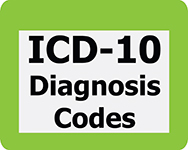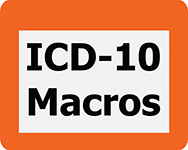Dr. Charles Major Discusses Cancer Killers

View more podcasts by our chiropractic friends.
Dr. Beau Pierce Circle of Docs Chiropractic Network

See another podcast on our Chiropractic Leaders Podcast page.
ICD-10 Codes for the Chiropractic Practice

ICD-10 diagnosis codes in a step-by-step free webinar. See what Genesis has built for ICD-10 diagnosis codes so your practice will get paid in full and on-time. View this free webinar to see exactly how Chiropractors can choose the correct ICD-10 codes. Comments so far have been positive, “Very Intuitive” and “Easy to Use.” If you’re not already our client, then schedule a free demo. Read the transcript: Jason: Welcome, everyone. It’s really good to have you here this afternoon. It’s Jason Barnes and joining me, as always, is my illustrious co-host to these webinars, Jessica Pancoast, the head of the training and help desk teams here at Vericle. We’re really excited to have everyone and this has been a hot topic. And so we are excited to talk about ICD-10 one more time. And so this will be a recap of a lot of the other webinars that you’ve seen including some of the system updates and what we’ve learned so far. It will not include all of the content because we won’t be doing things like macros today. We are just gonna include the actual system functionality for finding codes, choosing your ICD-10 codes based on your ICD-10s, how to search ICD-10 codes when you’re not cross walking over from an ICD-9 code and making sure that you know how to save those codes, save the searches and group them however you’d like to. So we’ve had some updates there and we’re really excited to share those today. Not only that, if you have not yet actually created those hierarchies in your system, we’re gonna show you how you can go about doing that with a test patient, and to kick it all off we’re actually gonna show you how to find your most popularly used or frequently used ICD-9 codes so you know which ones need to be mapped over. Jess, anything to add? Jessica: No, I think that covers everything that we need to go over. Jason: That’s what we’re planning on doing today. So, thank you for joining us and we’re just gonna dive right into it. Today everyone watching should be familiar with the screen that’s up. This is a fake patient where we are looking at the travel card. You can see there’s x-rays, there’s no ICD-10 or ICD-9 information, and we’re gonna go over that functionality. But before we get into that we actually want everyone to take a break and think about this process as a whole. In order to figure out which codes you’re gonna need to select so that you’re ready to more readily choose your ICD-10 codes, I wanna to take you into another system. This is actually a real practice in our system that we’re showing you right now. All the names have been changed so that we’re not using anybody’s real practice information, but this is the last year worth of billing information by diagnosis code. Our recommendation is that you run a billing status report to find out which ICD-9 codes you most frequently use because what we found is, although there are a number, 10,977 visits with 11,150 code selections used, there were only 40 total diagnosis codes used last year by this practice. And if you look at them by percentage, a vast majority of those visits were covered by 10 codes, 8 codes. So what we want you to do is know how to find out what those codes are for your office. To do that, you head to reports, go down to Billing Analytics, choose your billing stats report that’s how we got here. In the bottom of this report, I recommend going back one year, but six months should be adequate, you change the date range and most importantly you have to choose Diagnosis 1. Now, this might not exist in your drop-down or pop-up, in this case of selections. If it does not that is not a problem, you go back to reports…back to Billing Analytics and then choose your billing stats configuration report. This billing stats config right here will allow you to actually choose Diagnosis 1, make a name for it, save that name and then you’ll have to go back refresh your billing status report and that way you’ll be able to access that new code that you’ve just created for your billing status report. In this case, let’s make a note that 739.1 is the most commonly used code by this particular office. A high-volume office who sent out over 2345 claims in the last year with this diagnosis code on. Jessica, do you have anything else on the billing stats. Jessica: No, that explains all. The only thing I can think of is you wanna make sure that Insurance Only and Pip Only is unchecked down the bottom. Jason: Unchecked, great clarification, thanks. Okay, so getting back to it we want you to be able to create a hierarchy, create favorite codes that will allow you not have to search each time you have a new patient or an existing patient that walks through your door to know what your 739.1 equivalent or equivalents will be in ICD-10. So we’re actually gonna walk you through that process, but the first thing we need to let you know about the three areas where ICD-10 codes are going to be relevant to you. The first you’re gonna see is the ICD-10 traffic light which I am highlighting right now with my mouse. We’re not gonna click on that just yet but most things in our systems that have a color associated with it are drillable or clickable, you can click on those things. The second are the two lines right here where you used to see just your ICD-9 codes, but now you’ll see both ICD-9s and ICD-10s. And then, in two other places, you’re gonna get the same exact interface, both the Diagnoses tab as well as your EMR Assessment tab. And everyone
ICD-10 Macros In Your Chiropractic Office

ICD-10 Macros Make Documentation Easy. See what Genesis has built for ICD-10 for your practice to get paid in full and on-time. View this free webinar to see exactly how Chiropractors can use these macros and also customize them. Comments so far have been positive, “Very Intuitive” and “Easy to Use.” If you’re not already our client, then schedule a free demo. Read the transcript: Jason: Well, welcome everyone. Thanks for joining us. It’s Jessica Pancoast, Head of the Genesis Training Team and Help Desk, and my name is Jason Barnes, and we’re here to talk ICD-10 another time with you. And today we’re gonna start in a different direction that we have in previous ICD-10 webinars. So in the past we’ve done a few webinars which has been nearly identical going over the interface helping doctors find out which ICD-9 codes they use most frequently and then teaching them how to not only map them over but also how to create a set of favorites for those frequently used ICD-9 codes to match up with your ICD-10s so you can easily find them moving forward. Today, we’re actually gonna go in a different direction, to begin with. That direction is with documentation. Now, I want to make sure it’s really clear that we are not going to be telling you how to document specific clinical situations rather how to manipulate our system and make sure that you guys are ICD-10 ready with the note macros or those preset macros for documenting your visits that are so popular with so many of our doctors. If you do have a question during this I ask that you chat it in. We are keeping everyone else on the line muted and we will get started with that agenda. Jess, any other questions that have come through on things that people would like us to cover today? Jessica: Nope, none yet. Jason: None yet, perfect. So to start with that I’ve got a patient up on the screen, I’m gonna go over a brief overview of our TravelCard again right now, very colorful, I get that. It looks like a cockpit of a 747. However, everything is pretty useful here. We’ve got these tabs where my mouse is and I’m gonna make this even just a little bit bigger for everyone. We’ve got our EMR tab and our diagnosis tab. These are the two things that we’re going to focus on today. In your EMR tab, you’re going to come into any visit that you want to. I don’t care if it’s a first visit or a re-eval on their 10th or 12th visit and you’re gonna want to do the same things over and over again. If you know what type of diagnosis it is or you know how you handle a standard re-eval then you don’t want to spend time or waste time I should say doing the same things over and over again. The magic in our system is that we can load in note macro. That note macro is accessed by hitting the note macro button, hitting the load feature, and you’ll see choices come up, and this is our demo account, with how you can manipulate the buttons that are already pushed in our system that creates the narrative. So in this particular instance, we’re looking at a bunch of different macros and let’s just say we’re talking about personal injury. If I click on a personal injury note, I can replace the current note, meaning I can add to, excuse me, meaning I can wipe out everything that’s on this particular note and start over again, or I can add it to the current note. With this particular visit, I’m gonna cancel a lot of your…we already have a narrative written and I will show that right now. This narrative is generated by taking each individual line in our system, and this is the first line for the subjective where you have an onset date that’s chosen in this button, you know, the type of entry, the mechanism of entry, and this one it was trauma. The next one is the type of pain or discomfort being experienced, there’s swelling. We could put stiffness, tightness, I’ll add one here. And then we actually go in and try and qualify what type of pain that is. So in the next, you know, button, you can put different things. And as you keep choosing the location if it’s radiating somewhere you create this narrative. And you can see here, I’ve actually changed that narrative by clicking a button or two. What we found is that a lot of doctors find it really useful if they have very repetitive either injuries or situations to create prefabs or preheat buttons. That is our note macro. So if you load in the note macro go back in and actually, you know, choose one, our personal injury I will add to the current note, it will go in and add rows of information that will change the note that you don’t have to hit each time. Today, what we’re gonna be going over is how to go in and edit those so that they include your ICD-10 selections as opposed to just your ICD-9s. The first step is you’re gonna have to know what your ICD-10 mappings are and we’re gonna have Jess actually walked us through how to change those macros real-time today. So that’s the first thing we’re gonna go over and after we’re done with that we can actually go over the interface one more time for anybody who would like to stick around and see that. Sounds good for you Jess, because I have received a couple of emails in the last couple of minutes, will you be going over the interface? Jessica: We’ve actually…the one question that I see in the chat is actually are we going over macros? So we’ve got people who want both

